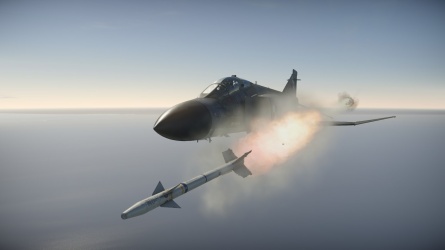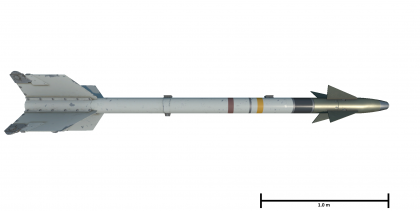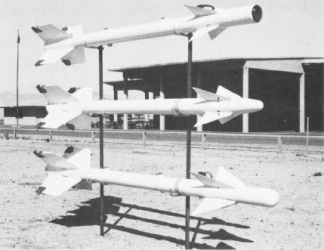AIM-9D Sidewinder
| This page is about the American air-to-air missile AIM-9D Sidewinder. For other versions, see AIM-9 Sidewinder (Family). |
Contents
Description
The AIM-9D Sidewinder is an American Infrared homing air-to-air missile. It was introduced in Update 1.93 "Shark Attack".
Vehicles equipped with this weapon
| Vehicles equipped with this weapon | |
|---|---|
| Jet fighters | |
| F-4 | Kurnass · F-4J Phantom II · Phantom FG.1 · Phantom FGR.2 |
| F-8 | F8U-2 · F-8E |
| F-14 | F-14A Early |
| Kfir | Kfir Canard · Kfir C.2 · Kfir C.7 |
| Mirage | Shahak · Nesher |
| Strike aircraft | Ayit · A-7E |
General info
The AIM-9D is a member of the Sidewinder family of missiles. It incorporates a number of improvements over the AIM-9B, from which it was developed. The AIM-9E was also a development of the AIM-9B rather than the AIM-9D; while the AIM-9D was developed for the US Navy, the AIM-9E was a separate development for the US Air Force. In game the AIM-9D is distinctly different from the AIM-9E. Due to its excellent characteristics, AIM-9D is decent in short-range combat, but where it really excels is at range; the long-burning engine gives AIM-9D good range and it can easily take opponents by surprise. Once activated, the missile search will last for a period of 20 seconds.
| Missile characteristics | |
|---|---|
| Mass | 88 kg |
| Guidance | IR |
| Aspect | Rear-aspect |
| Lock range (rear-aspect) | 5.5 km |
| Launch range | 18 km |
| Maximum speed | 2.5 M |
| Maximum overload | 18 G |
| Missile guidance time | 60 secs |
| Explosive mass | 4.69 kg TNTeq |
Effective damage
Like the AIM-9B & AIM-9E Sidewinders the AIM-9D is fitted with a 4.5 kg TNT warhead and 5 m proximity fuse. This amount of explosive mass is in the vast majority of cases enough to either outright destroy an enemy aircraft or cause non-survivable critical damage. There are some occasions where an enemy aircraft can survive a hit and make it back to base. If this is the case, however, they will be crippled, out of the fight, and an easy kill.
Comparison with analogues
Compared to other Sidewinders
The AIM-9D is a substantial improvement over the AIM-9B. The key improvements are:
- More effective fins
- Overload of 18 G instead of 10 G
- Rocket motor burns for 3.5 instead of 2.1 seconds
- Max speed of 1,000 m/s instead of 800 m/s
- Better IR seeker range
- Better tracking rate
- Smaller seeker circle
These changes make the AIM-9D a far superior all round missile. Once the missile is launched it tracks targets much better than the AIM-9B and has far superior speed and range. The only downside is that the AIM-9D's seeker circle is actually smaller than that of the AIM-9B, which means you must be pointing slightly closer to an aircraft to get a lock.
The AIM-9D is very similar to the AIM-9E, with the following key differences:
- More effective fins
- Overload of 18 G instead of 10 G
- Rocket motor burns for 3.5 instead of 2.1 seconds
- Max speed of 1,000 m/s instead of 800 m/s
- No uncaged seeker
The increased overload and improved fins mean the AIM-9D can track targets better than the AIM-9E. The other changes mean that the AIM-9D has a far superior effective range than the AIM-9E. While both missiles can theoretically fly 18,000 m from their point of launch; the AIM-9D's much longer burning motor and higher maximum speed means that it holds its speed much better at longer ranges and can remain effective at ranges where the AIM-9E would have lost too much speed to do so. It is not uncommon for AIM-9Ds to be able to hit targets in excess of 3 to 5 km from their point of launch (an even in excess of 7 km sometimes, depending on the conditions). However, unlike the AIM-9E, the AIM-9D does not have an uncaged seeker and therefore players cannot "lead" the missile.
Compared to other missiles
Compared to the Russian R-60, the AIM-9D is a very different missile with a different playstyle. The R-60 has more effective fins than the AIM-9D, a higher maximum overload, and a much higher tracking rate (more than double that of the AIM-9D). All this makes the R-60 a far superior weapon for short range engagements against manoeuvring targets. However, the AIM-9D excels at longer range engagements, being able to engage targets at ranges far beyond what the R-60 could ever hope to, even in ideal conditions. Under ideal conditions the R-60 has a maximum engagement range of around 3.5 km, however in combat the effective range is usually less than 2.5 km; by comparison under combat conditions the AIM-9D routinely take out targets at ranges in excess of 5 km, with even kills on targets as far away as 9 km having been observed in combat. The rocket motor on the R-60 burns for 0.5 seconds less than the AIM-9D, while also producing less than half the thrust, which coupled with its lower top speed and much lower flight time and flight distance limits severely restrict its range.
The incredible range of the AIM-9D is what distinguishes it from other air-to-air missiles in the game. It is also among the more manoeuvrable missiles currently available to jet aircraft.
- AIM-9B FGW.2 Sidewinder - A European-licensed version of the AIM-9B with their own improvements; however the performance in-game are quite similar.
- R-3S/PL-2 - Infamous as a reverse-engineered variant of the AIM-9B, the R-3 missile shares many of its in-game performances with the AIM-9B, only falling slightly short in locking and launching range.
- Shafrir - Shares in-game performance values despite their design differences
- Rb24 - Licensed-produced version of the AIM-9B for the Swedish, and as such shares in-game performance values.
| Missile | Guidance | Lock range (rear-aspect)(km) |
Launch range (km) |
Maximum speed (Mach) |
Maximum overload (g) |
Mass (kg) |
TNT Equivalent (kg) | |||||
|---|---|---|---|---|---|---|---|---|---|---|---|---|
| Type | Aspect | Time | Uncaged seeker | Radar slaving | ||||||||
| |
AIM-9B Sidewinder | IR | Rear | 20 | |
|
4 | 10 | 1.7 | 10 | 72 | 7.62 |
| |
AIM-9C Sidewinder | SARH | Front | 60 | |
|
9 | 18 | 2.5 | 18 | 95 | 4.69 |
| |
AIM-9D Sidewinder[note 1] | IR | Rear | 20 | |
|
5.5 | 18 | 2.5 | 18 | 88 | 4.69 |
| |
AIM-9E Sidewinder[note 2] | IR | Rear | 20 | |
|
5.5 | 18 | 2.8 | 10 | 76 | 7.62 |
| |
AIM-9G Sidewinder | IR | Rear | 60 | |
|
5.5 | 18 | 2.5 | 18 | 88 | 3.53 |
| |
AIM-9H Sidewinder | IR | Rear | 60 | |
|
5.5 | 18 | 2.5 | 18 | 88 | 3.53 |
| |
AIM-9J Sidewinder[note 3] | IR | Rear | 40 | |
|
5.5 | 18 | 2.5 | 20 | 76 | 7.62 |
| |
AIM-9L Sidewinder | IR | All | 60 | |
|
11 | 18 | 2.5 | 30 | 84 | 4.58 |
| |
AIM-9M Sidewinder | IR | All | 60 | |
|
11 | 18 | 2.5 | 30 | 84 | 4.58 |
| |
AIM-9P Sidewinder | IR | Rear | 40 | |
|
5.5 | 18 | 2.5 | 20 | 76.93 | 7.62 |
| |
AIM-9P4 Sidewinder | IR | All | 40 | |
|
11 | 18 | 2.5 | 20 | 76.93 | 7.62 |
| |
AIM-9B FGW.2 Sidewinder | IR | Rear | 20 | |
|
5.5 | 10 | 1.7 | 10 | 72 | 7.62 |
| |
Shafrir | IR | Rear | 20 | |
|
7 | 10 | 1.7 | 11 | 65 | 7.62 |
| |
RB24 | IR | Rear | 20 | |
|
4 | 10 | 1.7 | 10 | 72 | 7.62 |
| |
R-3S | IR | Rear | 21 | |
|
9 | 10 | 1.7 | 10 | 75 | 8.8 |
| |
PL-2 | IR | Rear | 21 | |
|
9 | 10 | 1.7 | 10 | 75 | 8.8 |
Usage in battles
What the AIM-9D truly excels is in longer range engagements. Ideally you should fire the AIM-9D at a target 2 km or more away from you. The AIM-9D has a stated maximum locking distance of 5 km; in practice this means that from the rear you can lock on to most non-afterburning jets at about 4.5 km; however as afterburners produce a lot of heat you can lock on to an afterburning jet as far away as 10 km (with a small possibility of even hitting them). The missile has decent manoeuvrability and may be launched at a closer range, but this increases the chance of the enemy seeing and dodging the missile; doing so isn't fully exploiting the AIM-9D's capabilities.
When engaging a target with the AIM-9D, further really is better (to an extent). The more distance the missile has, the better it is able to follow a flight path leading it to the target, and the more likely it is that the enemy will be unaware of your presence. Keep in mind that at higher altitudes, missiles gain more range due to lessened drag, so the higher you go, the longer the range of the missile gets. At lower levels, you can routinely engage targets located 3 km away from you, and at altitude (>5,000 m), missile launches at 5 km have a good chance of hitting (assuming the enemy doesn't take evasive action). Although kills at 9 km have been observed, you are definitely "trying your luck" at those ranges, so it's recommended not to try it.
At very short ranges (typically a bit less than 1,000 m) the AIM-9D can lock on to an afterburning jet from the front, while this is usually of little use (it cannot really manoeuvre at that sort of range and angle of attack), it can be useful in head-on attacks.
Pros and cons
Pros:
- Good range, can hit targets up to 4 km away from you
- Slightly more powerful and much longer burning (2.1 vs 3.5 seconds) rocket motor than the AIM-9E
- Has a very good 18 G overload
Cons:
- Tiny seeker circle, even smaller than that of the AIM-9B
- Has a much lower tracking rate than the R-60, making it less effective at tracking targets in comparison
History
Development
The missile's history starts at the Naval Ordnance Test Station (NOTS) at China Lake in 1947.[1] Under William B. McLean, the missile conception sprang from mating lead-sulfide proximity fuzes that were sensitive to infrared radiation with a guidance system to home onto the infrared source.[2] Initially his own private project, McLean eventually received approval by Admiral William S. Parsons for development.[1]These missiles were first test fired in 1951, with the first air-to-air hit was made on 11 September 1953 on a drone.[3] This experimental missile would be designated as the XAAM-N-7. The missile would also earn the name "Sidewinder" by the development team, named after the desert rattlesnake that senses its prey's heat and moves in a winding motion.[1][2]
Initially a US Navy project, the US Air Force was urged into participating by Howard Wilcox, the next project lead after McLean was promoted to upper management at NOTS in 1954.[1] This culminated in a shoot-off in June 1955 between the Navy's Sidewinder against the Air Force's GAR-2 Falcon missile. The Sidewinder's performance in this event resulted in the US Air Force putting their support in the Sidewinder.[3] By May 1956, the missile was officially adopted as the AAM-N-7 for the US Navy and the GAR-8 for the US Air Force.[3][4] These designation would remain until 27 June 1963, when the Sidewinder's designations were standardised across all armed services as the AIM-9.[5]
AIM-9D
Recognizing the limitations the initial production Sidewinder had, the US Navy set to work to improve the missile. The construction of the missile nose was changed into a streamlined ogival nose. The optical seeker was improved with a wider field of view, and the infrared seeker with a reduced field of view to downplay background noise.[3][6] A new nitrogen cooling system was installed for the fuse, which enhanced head sensitivity for the missile.[2][6] Manoeuvrability was improved with a faster seeker tracking rate, as well as a new actuator system.[6] The Sidewinder's missile range was improved with new Hercules MK 36 solid-fuel rocket motor that allowed the missile to have a 18 km range.[3] Finally, a new Mk 48 continuous-rod warhead was fitted to the missile for increased lethality, which also allowed for an infrared or a radio proximity fuse.[1][3][6] These improvements were settled into the AIM-9D variant for the US Navy. About 1,000 AIM-9D units were produced between 1965 and 1969.[3]
In 1963, the US Army's Missile Command (MICOM) were interested in the US Navy's development of the AIM-9D and looked into a possible conversion of the missile into a surface-to-air role. The feasibility was seen as possible by 1965 and so the US Army looked into making the AIM-9D the main armament of their Chaparral program.[7] These modified AIM-9D Sidewinders were delivered in 1967 and designated XMIM-72A, which were later approved as the MIM-72A.[7] The only major difference to the missile is that only two of the four fins have rollerons (stabilising gyros), while the other two were made non-moving.[1][7]
Continual improvements over the AIM-9D version eventually developed into the AIM-9G in the 1970s.[3]
Media
Excellent additions to the article would be video guides, screenshots from the game, and photos.
See also
- Related development
- Similar-performing missiles
External links
References
- Citations
- Bibliography
- Gervasi, Tom. America's War Machine: the Pursuit of Global Dominance: Arsenal of Democracy III. Grove Press, Inc., 1984.
- Goebel, Greg. "The Falcon & Sidewinder Air-To-Air Missiles." Air Vectors, 01 Apr. 2019, Website.
- Hollway, Don. "The AIM-9 Sidewinder: Fox Two!" HistoryNet, Website.
- Kopp, Carlo. "The Sidewinder Story: The Evolution of the AIM-9 Missile." Air Power Australia, 27 Jan 2014, Website.
- Parsch, Andreas. "AIM-9." Directory of U.S. Military Rockets and Missiles, Designation-Systems.Net, 09 July 2008, Website.
- Parsch, Andreas. "Current Designations of U.S. Unmanned Military Aerospace Vehicles." U.S. Military Aviation Designation Systems, Designation-Systems.Net, 30 March 2020, Website.
- Parsch, Andreas. "MIM-72." Directory of U.S. Military Rockets and Missiles, Designation-Systems.Net, 20 Feb. 2002, Website.






